One Font Doesn’t Fit All: The Influence of Digital Text Personalization on Comprehension in Child and Adolescent Readers
Abstract
1. Introduction
1.1. Reading Comprehension Steps
1.2. Factors That Influence Reading
1.3. Typography Research in Adults
1.4. Typography Research in Children
1.5. Font Format Personalization
1.6. Current Study
2. Experiment 1
2.1. Experiment 1 Materials and Methods
2.1.1. Participants
2.1.2. Materials
2.1.3. Font Variations
2.1.4. Procedure
2.1.5. Questionnaires
2.1.6. Masked Semantic Categorization Task
2.1.7. Data Analysis
2.2. Experiment 1 Results
2.2.1. Group-Level Results
Reading Speed (Reaction Time)
Reading Comprehension Accuracy
2.2.2. Individual Level Results (Font Format Personalization)
2.3. Experiment 1 Discussion
2.3.1. Group Level
2.3.2. Individual Reader Font Format Personalization
3. Experiment 2
3.1. Experiment 2 Materials and Methods
3.1.1. Participants
3.1.2. Materials
3.1.3. Procedure
3.1.4. Font Variations
3.1.5. Data Analysis
3.2. Experiment 2 Results
3.2.1. Group-Level Results
Reading Speed (WPM)
Reading Comprehension Accuracy
3.2.2. Individual-Level Results (Personal Best vs. Worst Font Variation)—Exploratory Analyses
3.3. Experiment 2 Discussion
3.3.1. Group Level
3.3.2. Individual Reader Personal Best vs. Worst Font Variation (Exploratory Analyses)
4. General Discussion
Educational Impact and Implications—The Promise of Digital Technology
5. Conclusions
Author Contributions
Funding
Institutional Review Board Statement
Informed Consent Statement
Data Availability Statement
Conflicts of Interest
References
- Gaab, N. How Can We Ensure That Every Child Will Learn to Read? The Need for a Global, Neurodevelopmental Perspective; International Dyslexia Association: Pikesville, MD, USA, 2019; Available online: https://dyslexiaida.org/how-can-we-ensure-that-every-child-will-learn-to-read-the-need-for-a-global-neurodevelopmental-perspective/ (accessed on 19 March 2020).
- Bandeira de Mello, V.; Rahman, T.; Fox, M.A.; Ji, C.S. Mapping State Proficiency Standards Onto the NAEP Scales: Results From the 2017 NAEP Reading and Mathematics Assessments (NCES 2019-040); U.S. Department of Education. Institute of Education Sciences, National Center for Education Statistics: Washington, DC, USA, 2019.
- Harrison, E.; McTavish, M. ‘I’Babies: Infants’ and Toddlers’ Emergent Language and Literacy in a Digital Culture of IDevices. J. Early Child. Lit. 2018, 18, 163–188. [Google Scholar] [CrossRef]
- Dobler, E. E-textbooks: A Personalized Learning Experience or a Digital Distraction? J. Adolesc. Adult Lit. 2015, 58, 482–491. [Google Scholar] [CrossRef]
- Hourcade, J.P.; Bederson, B.B.; Druin, A.; Rose, A.; Farber, A.; Takayama, Y. The International Children’s Digital Library: Viewing Digital Books Online. Interact. Comput. 2003, 15, 151–167. [Google Scholar] [CrossRef][Green Version]
- Markopoulos, P.; Read, J.C.; Giannakos, M. Design of Digital Technologies for Children. In Handbook of Human Factors and Ergonomics, 5th ed.; Salvendy, G., Karwowski, W., Eds.; Wiley: New York, NY, USA, 2021; pp. 1287–1304. [Google Scholar]
- Beier, S.; Berlow, S.; Boucaud, E.; Bylinskii, Z.; Cai, T.; Cohn, J.; Crowley, K.; Day, S.L.; Dingler, T.; Dobres, J. Readability Research: An Interdisciplinary Approach. Found. Trends®® Hum.–Comput. Interact. 2022, 16, 214–324. [Google Scholar] [CrossRef]
- Coltheart, M. Lexical acces in simple reading tasks. In Strategies of Information Processing; Underwood, G., Ed.; Academic Press: San Diego, CA, USA, 1978; pp. 11–21. [Google Scholar]
- Coltheart, M.; Rastle, K.; Perry, C.; Langdon, R.; Ziegler, J. DRC: A Dual Route Cascaded Model of Visual Word Recognition and Reading Aloud. Psychol. Rev. 2001, 108, 204. [Google Scholar] [CrossRef] [PubMed]
- Coltheart, M.; Rastle, K. Serial Processing in Reading Aloud: Evidence for Dual-Route Models of Reading. J. Exp. Psychol. Hum. Percept. Perform. 1994, 20, 1197. [Google Scholar] [CrossRef][Green Version]
- Cain, K.; Oakhill, J.V.; Barnes, M.A.; Bryant, P.E. Comprehension Skill, Inference-Making Ability, and Their Relation to Knowledge. Mem. Cogn. 2001, 29, 850–859. [Google Scholar] [CrossRef]
- Scarborough, H.S.; Neuman, S.; Dickinson, D. Connecting Early Language and Literacy to Later Reading (Dis) Abilities: Evidence, Theory, and Practice. Approaching Difficulties Lit. Dev. Assess. Pedagog. Programmes 2009, 10, 23–38. [Google Scholar]
- Butterfuss, R.; Kendeou, P. The Role of Executive Functions in Reading Comprehension. Educ. Psychol. Rev. 2018, 30, 801–826. [Google Scholar] [CrossRef]
- Cain, K.; Oakhill, J.; Bryant, P. Children’s Reading Comprehension Ability: Concurrent Prediction by Working Memory, Verbal Ability, and Component Skills. J. Educ. Psychol. 2004, 96, 31. [Google Scholar] [CrossRef]
- Corso, H.V.; Cromley, J.G.; Sperb, T.; Salles, J.F. Modeling the Relationship among Reading Comprehension, Intelligence, Socioeconomic Status, and Neuropsychological Functions: The Mediating Role of Executive Functions. Psychol. Neurosci. 2016, 9, 32. [Google Scholar] [CrossRef]
- Nouwens, S.; Groen, M.A.; Kleemans, T.; Verhoeven, L. How Executive Functions Contribute to Reading Comprehension. Br. J. Educ. Psychol. 2021, 91, 169–192. [Google Scholar] [CrossRef] [PubMed]
- Seigneuric, A.; Ehrlich, M.-F.; Oakhill, J.V.; Yuill, N.M. Working Memory Resources and Children’s Reading Comprehension. Read. Writ. 2000, 13, 81–103. [Google Scholar] [CrossRef]
- Carroll, J.B. Human Cognitive Abilities: A Survey of Factor-Analytic Studies; Cambridge University Press: New York, NY, USA, 1993. [Google Scholar]
- Oakhill, J.; Cain, K.; Elbro, C. Reading Comprehension and Reading Comprehension Difficulties. In Reading Development and Difficulties; Springer: Berlin/Heidelberg, Germany, 2019; pp. 83–115. [Google Scholar]
- Ouellette, G.P. What’s Meaning Got to Do with It: The Role of Vocabulary in Word Reading and Reading Comprehension. J. Educ. Psychol. 2006, 98, 554. [Google Scholar] [CrossRef]
- Seigneuric, A.; Ehrlich, M.-F. Contribution of Working Memory Capacity to Children’s Reading Comprehension: A Longitudinal Investigation. Read. Writ. 2005, 18, 617–656. [Google Scholar] [CrossRef]
- Van Dyke, J.A.; Johns, C.L.; Kukona, A. Low Working Memory Capacity Is Only Spuriously Related to Poor Reading Comprehension. Cognition 2014, 131, 373–403. [Google Scholar] [CrossRef] [PubMed]
- Kieffer, M.J. Socioeconomic Status, English Proficiency, and Late-Emerging Reading Difficulties. Educ. Res. 2010, 39, 484–486. [Google Scholar] [CrossRef]
- Lervåg, A.; Dolean, D.; Tincas, I.; Melby-Lervåg, M. Socioeconomic Background, Nonverbal IQ and School Absence Affects the Development of Vocabulary and Reading Comprehension in Children Living in Severe Poverty. Dev. Sci. 2019, 22, e12858. [Google Scholar] [CrossRef]
- Dahlin, K.I. Effects of Working Memory Training on Reading in Children with Special Needs. Read. Writ. 2011, 24, 479–491. [Google Scholar] [CrossRef]
- Novaes, C.B.; Zuanetti, P.A.; Fukuda, M.T.H. Effects of Working Memory Intervention on Students with Reading Comprehension Difficulties. Revista CEFAC 2019, 21, 4. [Google Scholar] [CrossRef]
- Kjeldsen, A.-C.; Kärnä, A.; Niemi, P.; Olofsson, Å.; Witting, K. Gains from Training in Phonological Awareness in Kindergarten Predict Reading Comprehension in Grade 9. Sci. Stud. Read. 2014, 18, 452–467. [Google Scholar] [CrossRef]
- Gellert, A.S.; Arnbak, E.; Wischmann, S.; Elbro, C. Morphological Intervention for Students With Limited Vocabulary Knowledge: Short-and Long-Term Transfer Effects. Read. Res. Q. 2021, 56, 583–601. [Google Scholar] [CrossRef]
- Pfost, M.; Blatter, K.; Artelt, C.; Stanat, P.; Schneider, W. Effects of Training Phonological Awareness on Children’s Reading Skills. J. Appl. Dev. Psychol. 2019, 65, 101067. [Google Scholar] [CrossRef]
- Oderkerk, C.A.; Beier, S. Fonts of Wider Letter Shapes Improve Letter Recognition in Parafovea and Periphery. Ergonomics 2021, 65, 753–761. [Google Scholar] [CrossRef] [PubMed]
- Beier, S.; Oderkerk, C.A.; Bay, B.; Larsen, M. Increased Letter Spacing and Greater Letter Width Improve Reading Acuity in Low Vision Readers. Inf. Des. J. 2021, 26, 73–88. [Google Scholar] [CrossRef]
- McLeish, E. A Study of the Effect of Letter Spacing on the Reading Speed of Young Readers with Low Vision. Br. J. Vis. Impair. 2007, 25, 133–143. [Google Scholar] [CrossRef]
- Yu, D.; Cheung, S.-H.; Legge, G.E.; Chung, S.T. Effect of Letter Spacing on Visual Span and Reading Speed. J. Vis. 2007, 7, 2. [Google Scholar] [CrossRef] [PubMed]
- Minakata, K.; Beier, S. The Effect of Font Width on Eye Movements during Reading. Appl. Ergon. 2021, 97, 103523. [Google Scholar] [CrossRef]
- Sawyer, B.D.; Dobres, J.; Chahine, N.; Reimer, B. The Cost of Cool: Typographic Style Legibility in Reading at a Glance. In Proceedings of the Human Factors and Ergonomics Society Annual Meeting; SAGE Publications Sage: Los Angeles, CA, USA, 2017; Volume 61, pp. 833–837. [Google Scholar]
- Chung, S.T.L. The Effect of Letter Spacing on Reading Speed in Central and Peripheral Vision. Investig. Ophthalmol. Vis. Sci. 2002, 43, 1270–1276. [Google Scholar]
- Legge, G.E.; Rubin, G.S.; Pelli, D.G.; Schleske, M.M. Psychophysics of Reading—II. Low Vision. Vis. Res. 1985, 25, 253–265. [Google Scholar] [CrossRef]
- Bouma, H. Interaction Effects in Parafoveal Letter Recognition. Nature 1970, 226, 177–178. [Google Scholar] [CrossRef] [PubMed]
- Coates, D.R.; Levi, D.M.; Touch, P.; Sabesan, R. Foveal Crowding Resolved. Sci. Rep. 2018, 8, 1–12. [Google Scholar] [CrossRef] [PubMed]
- Van Overschelde, J.P.; Healy, A.F. A Blank Look in Reading: The Effect of Blank Space on the Identification of Letters and Words during Reading. Exp. Psychol. 2005, 52, 213–223. [Google Scholar] [CrossRef] [PubMed]
- Hughes, L.; Wilkins, A. Reading at a Distance: Implications for the Design of Text in Children’s Big Books. Br. J. Educ. Psychol. 2002, 72, 213–226. [Google Scholar] [CrossRef] [PubMed]
- Wilkins, A.; Cleave, R.; Grayson, N.; Wilson, L. Typography for Children May Be Inappropriately Designed. J. Res. Read. 2009, 32, 402–412. [Google Scholar] [CrossRef]
- Siu, C.R.; Murphy, K.M. The Development of Human Visual Cortex and Clinical Implications. Eye Brain 2018, 10, 25. [Google Scholar] [CrossRef] [PubMed]
- Chall, J.S. Stages of Reading Development; McGraw-Hill: New York, NY, USA, 1983. [Google Scholar]
- Perea, M.; Panadero, V.; Moret-Tatay, C.; Gómez, P. The Effects of Inter-Letter Spacing in Visual-Word Recognition: Evidence with Young Normal Readers and Developmental Dyslexics. Learn. Instr. 2012, 22, 420–430. [Google Scholar] [CrossRef]
- Łuniewska, M.; Wójcik, M.; Jednoróg, K. The Effect of Inter-Letter Spacing on Reading Performance and Eye Movements in Typically Reading and Dyslexic Children. Learn. Instr. 2022, 80, 101576. [Google Scholar] [CrossRef]
- Katzir, T.; Hershko, S.; Halamish, V. The Effect of Font Size on Reading Comprehension on Second and Fifth Grade Children: Bigger Is Not Always Better. PLoS ONE 2013, 8, e74061. [Google Scholar] [CrossRef][Green Version]
- Medved, T.; Podlesek, A.; Možina, K. Influence of letter shape on readers’ emotional experience, reading fluency, and text comprehension and memorisation. Front. Psychol. 2023, 14, 457. [Google Scholar] [CrossRef]
- Spinelli, D.; De Luca, M.; Judica, A.; Zoccolotti, P. Crowding Effects on Word Identification in Developmental Dyslexia. Cortex 2002, 38, 179–200. [Google Scholar] [CrossRef] [PubMed]
- Zorzi, M.; Barbiero, C.; Facoetti, A.; Lonciari, I.; Carrozzi, M.; Montico, M.; Bravar, L.; George, F.; Pech-Georgel, C.; Ziegler, J.C. Extra-Large Letter Spacing Improves Reading in Dyslexia. Proc. Natl. Acad. Sci. USA 2012, 109, 11455–11459. [Google Scholar] [CrossRef] [PubMed]
- Callens, M.; Whitney, C.; Tops, W.; Brysbaert, M. No Deficiency in Left-to-Right Processing of Words in Dyslexia but Evidence for Enhanced Visual Crowding. Q. J. Exp. Psychol. 2013, 66, 1803–1817. [Google Scholar] [CrossRef] [PubMed]
- Gori, S.; Facoetti, A. How the Visual Aspects Can Be Crucial in Reading Acquisition: The Intriguing Case of Crowding and Developmental Dyslexia. J. Vis. 2015, 15, 8. [Google Scholar] [CrossRef] [PubMed]
- Martelli, M.; Di Filippo, G.; Spinelli, D.; Zoccolotti, P. Crowding, Reading, and Developmental Dyslexia. J. Vis. 2009, 9, 14. [Google Scholar] [CrossRef] [PubMed]
- Moll, K.; Jones, M. Naming Fluency in Dyslexic and Nondyslexic Readers: Differential Effects of Visual Crowding in Foveal, Parafoveal, and Peripheral Vision; SAGE Publications Sage: London, UK, 2013. [Google Scholar]
- Wallace, S.; Treitman, R.; Kumawat, N.; Arpin, K.; Huang, J.; Sawyer, B.; Bylinskii, Z. Towards Readability Individuation: The Right Changes to Text Format Make Large Impacts on Reading Speed. J. Vis. 2020, 20, 17. [Google Scholar]
- Wallace, S.; Bylinskii, Z.; Dobres, J.; Kerr, B.; Berlow, S.; Treitman, R.; Kumawat, N.; Arpin, K.; Miller, D.B.; Huang, J. Towards Individuated Reading Experiences: Different Fonts Increase Reading Speed for Different Individuals. ACM Trans. Comput.-Hum. Interact. (TOCHI) 2022, 29, 1–56. [Google Scholar] [CrossRef]
- Rayner, K.; Schotter, E.R.; Masson, M.E.; Potter, M.C.; Treiman, R. So Much to Read, so Little Time: How Do We Read, and Can Speed Reading Help? Psychol. Sci. Public Interest 2016, 17, 4–34. [Google Scholar] [CrossRef]
- Bernard, M.L.; Chaparro, B.S.; Mills, M.M.; Halcomb, C.G. Examining Children’s Reading Performance and Preference for Different Computer-Displayed Text. Behav. Inf. Technol. 2002, 21, 87–96. [Google Scholar] [CrossRef]
- Balota, D.A.; Yap, M.J.; Hutchison, K.A.; Cortese, M.J.; Kessler, B.; Loftis, B.; Neely, J.H.; Nelson, D.L.; Simpson, G.B.; Treiman, R. The English Lexicon Project. Behav. Res. Methods 2007, 39, 445–459. [Google Scholar] [CrossRef]
- Bredikhina, L. Variable Fonts from Pioneer Perspectives. In Handbook of Research on User Experience in Web 2.0 Technologies and Its Impact on Universities and Businesses; IGI Global: Hershey, PA, USA, 2021; pp. 55–72. [Google Scholar]
- Karow, P. Typeface Statistics; URW: Hamburg, Germany, 1993. [Google Scholar]
- Legge, G.E.; Bigelow, C.A. Does print size matter for reading? A review of findings from vision science and typography. J. Vis. 2011, 11, 8. [Google Scholar] [CrossRef] [PubMed]
- Anwyl-Irvine, A.L.; Massonnié, J.; Flitton, A.; Kirkham, N.; Evershed, J.K. Gorilla in Our Midst: An Online Behavioral Experiment Builder. Behav. Res. Methods 2020, 52, 388–407. [Google Scholar] [CrossRef] [PubMed]
- Frankish, C.; Turner, E. SIHGT and SUNOD: The Role of Orthography and Phonology in the Perception of Transposed Letter Anagrams. J. Mem. Lang. 2007, 56, 189–211. [Google Scholar] [CrossRef]
- Lee, B.; Martinez, P.M.; Midgley, K.J.; Holcomb, P.J.; Emmorey, K. Sensitivity to orthogrphic vs. phonological constraints on word recognition: An ERP study with deaf and hearing readers. Neuropsychologia 2022, 177, 108420. [Google Scholar] [CrossRef] [PubMed]
- Fleischhauer, E.; Bruns, G.; Grosche, M. Morphological decomposition supports word recognition in primary school children learning to read. Evidence from masked priming of German derived words. J. Res. Read. 2021, 44, 90–109. [Google Scholar] [CrossRef]
- Bates, D.; Mächler, M.; Bolker, B.; Walker, S. Fitting Linear Mixed-Effects Models Using Lme4. J. Stat. Softw. 2015, 67, 1–48. [Google Scholar] [CrossRef]
- R Core Team. R: A Language and Environment for Statistical Computing. 2020. Available online: https://www.R-project.org/ (accessed on 19 March 2020).
- Minakata, K.; Eckmann-Hansen, C.; Larsen, M.; Bek, T.; Beier, S. The effect of serifs and stroke contrast on low vision readers with autosomal dominant optic atrophy. Acta Psychol. 2023, 232, 103810. [Google Scholar] [CrossRef]
- Minakata, K.; Beier, S. The dispute about sans serif versus serif fonts: An interaction between the variables of serif and stroke contrast. Acta Psychol. 2022, 228, 103623. [Google Scholar] [CrossRef]
- Adjerid, I.; Kelley, K. Big Data in Psychology: A Framework for Research Advancement. Am. Psychol. 2018, 73, 899. [Google Scholar] [CrossRef]
- Bridges, D.; Pitiot, A.; MacAskill, M.R.; Peirce, J.W. The Timing Mega-Study: Comparing a Range of Experiment Generators, Both Lab-Based and Online. PeerJ 2020, 8, e9414. [Google Scholar] [CrossRef]
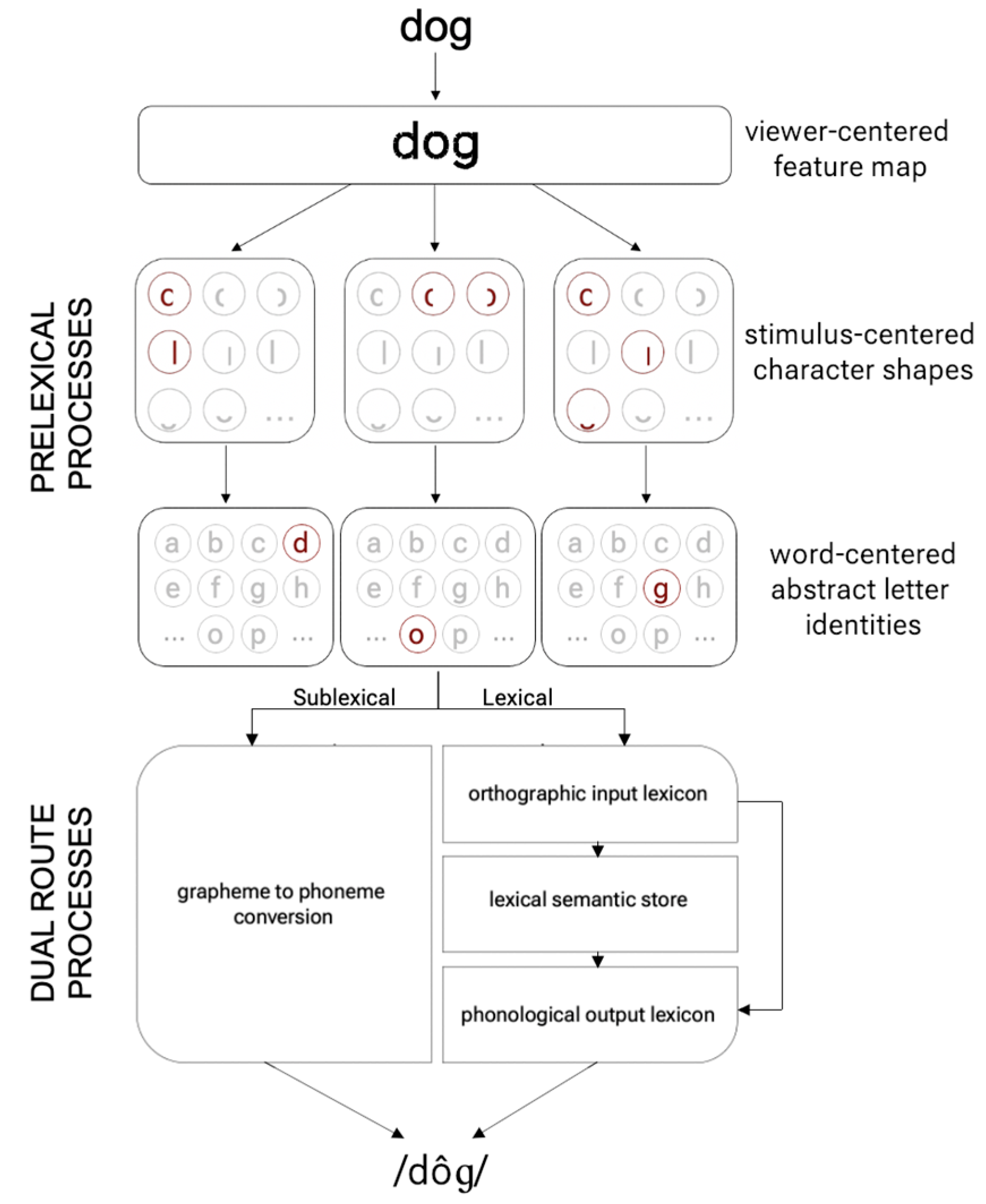

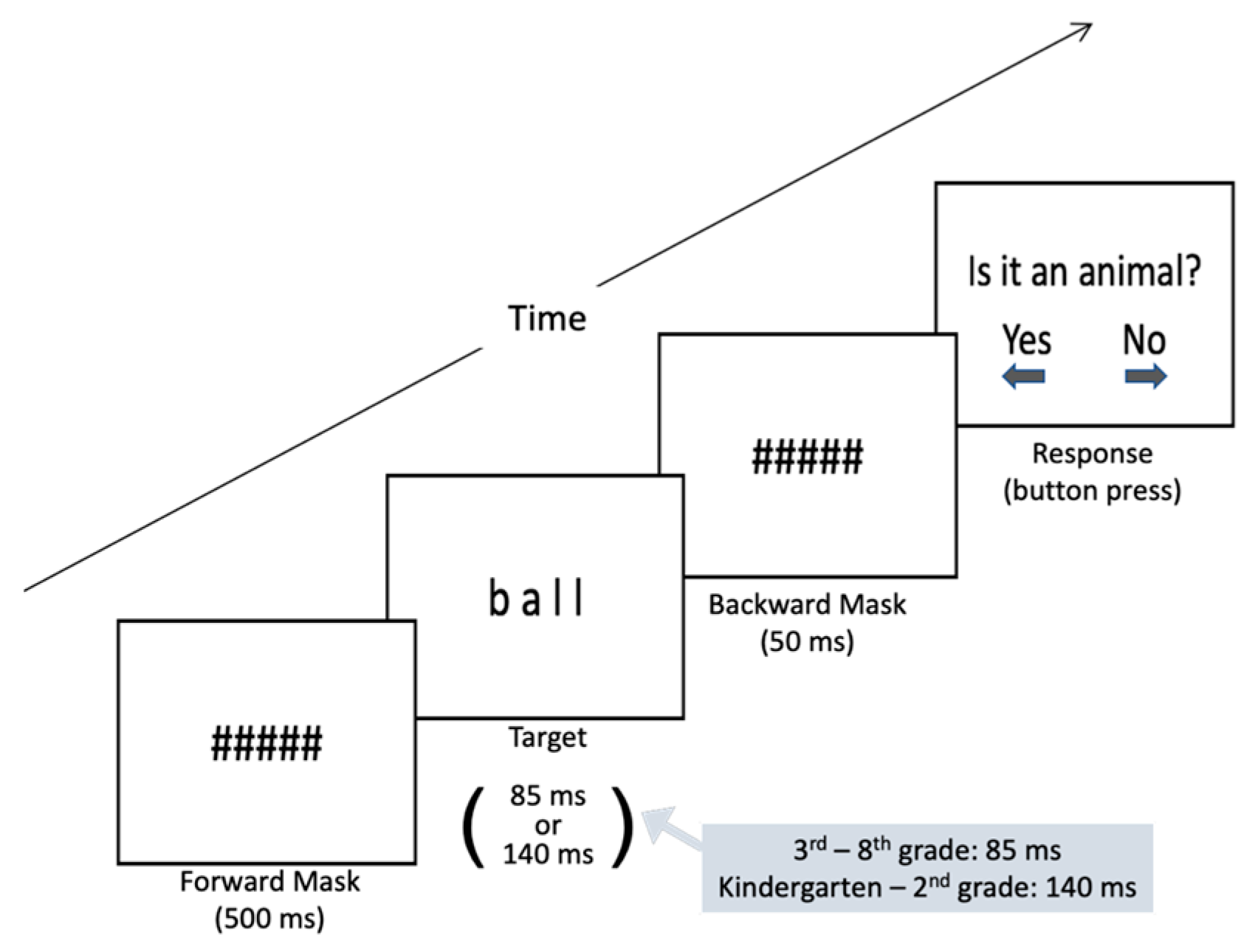

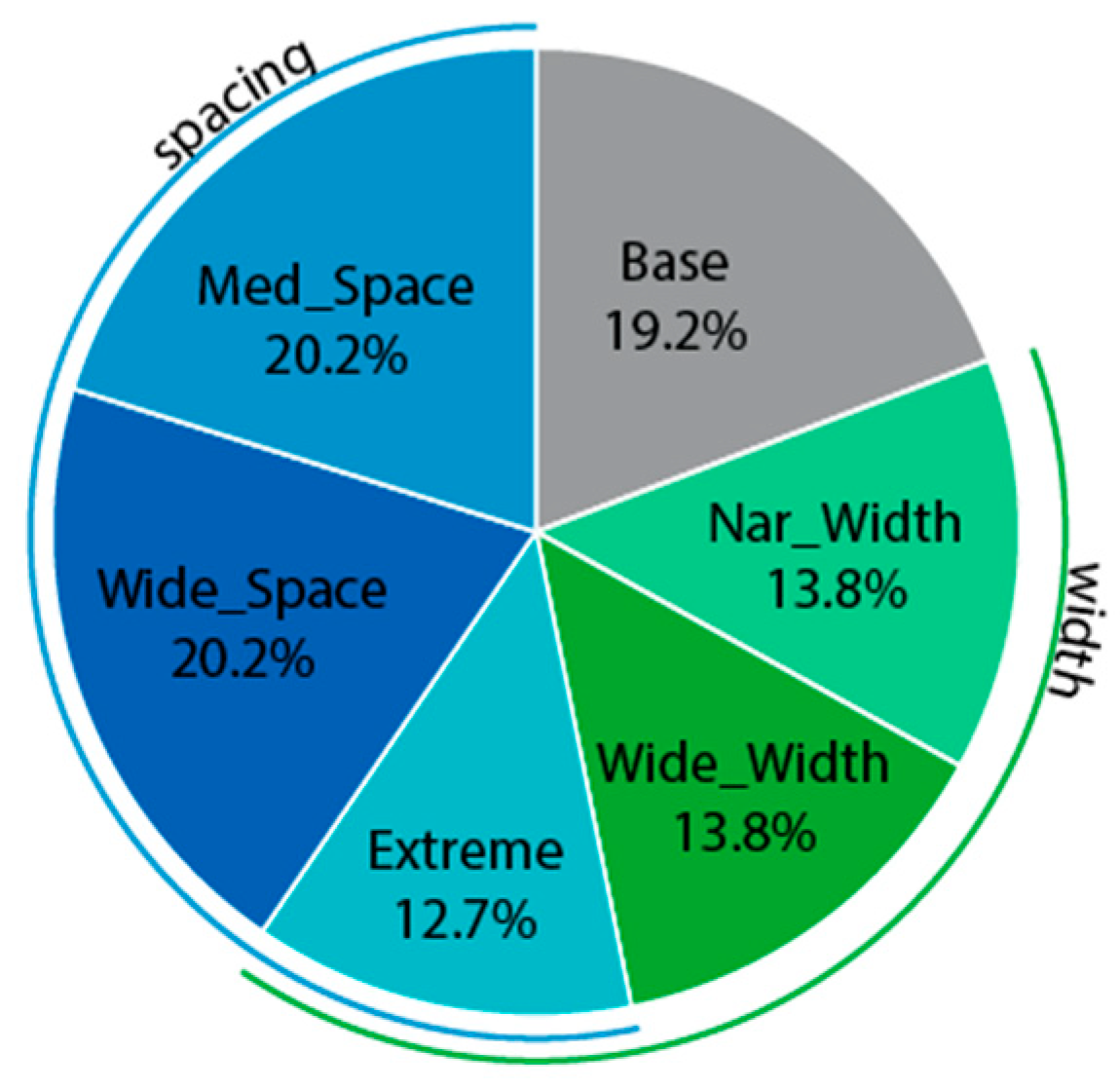
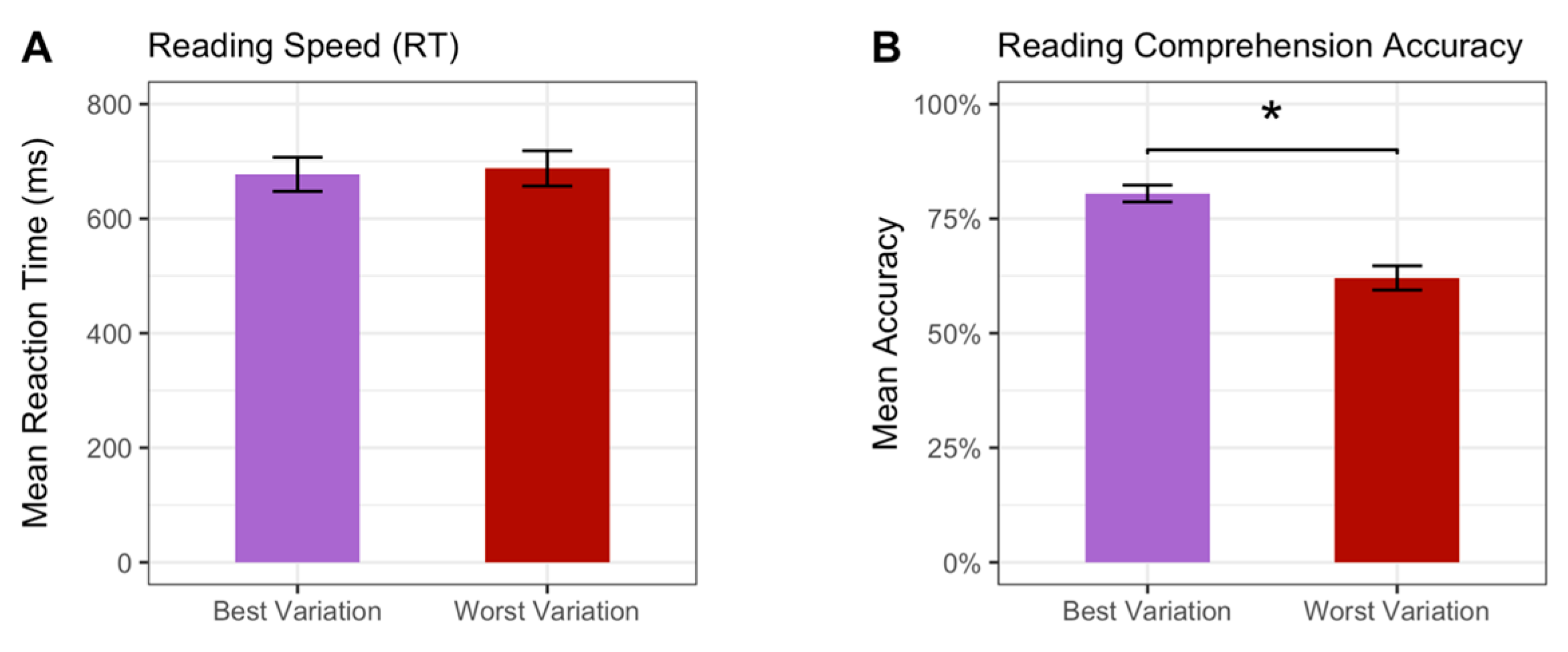
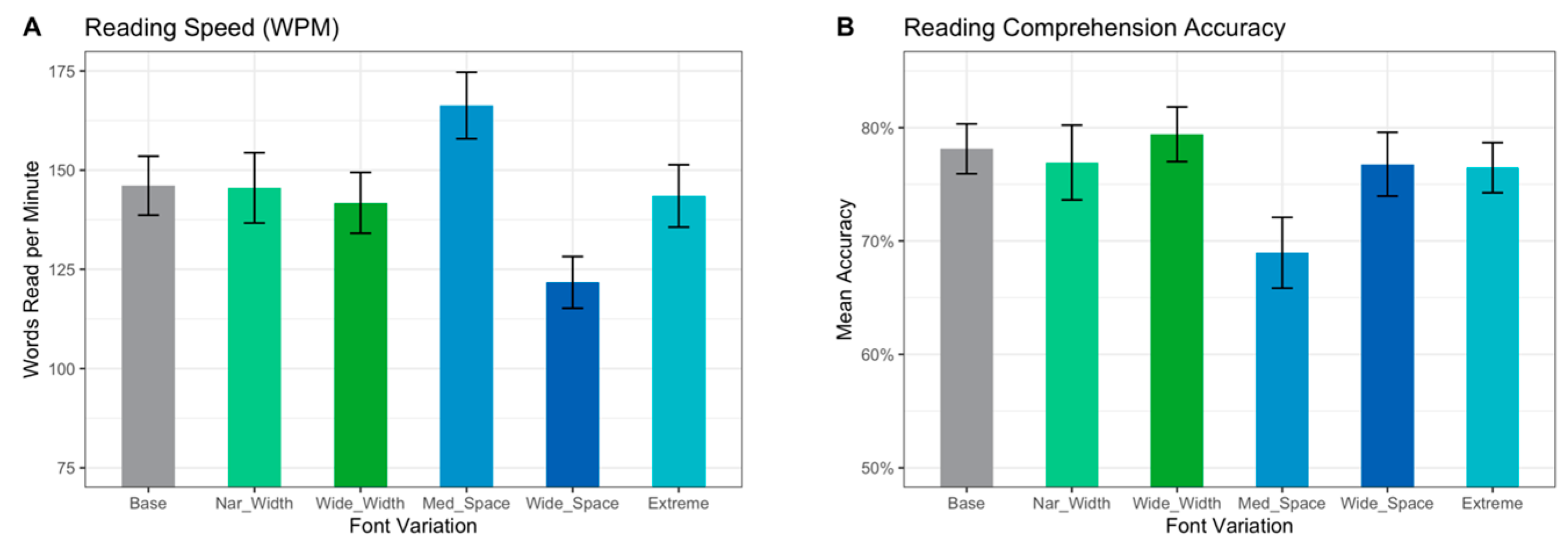
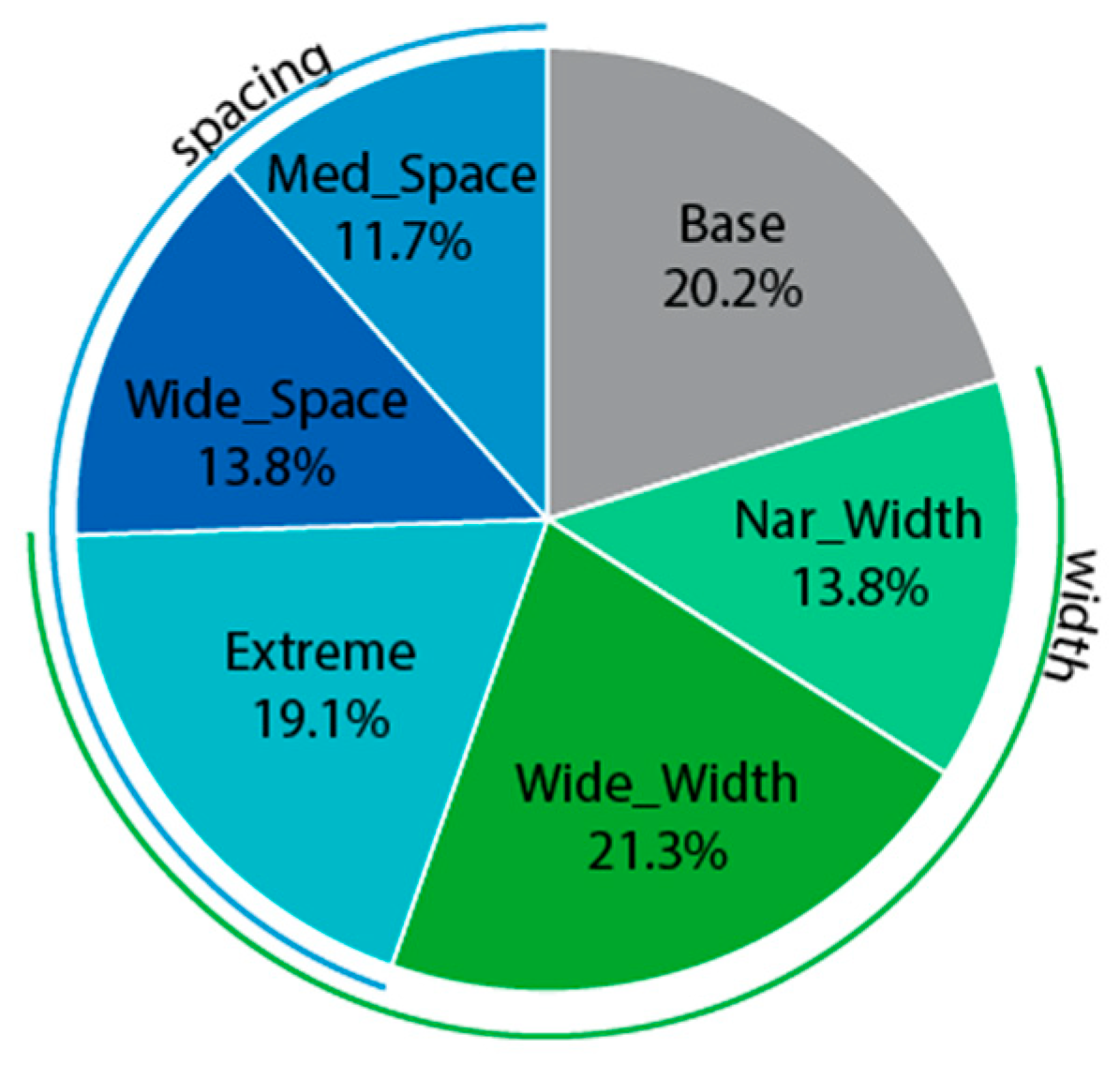
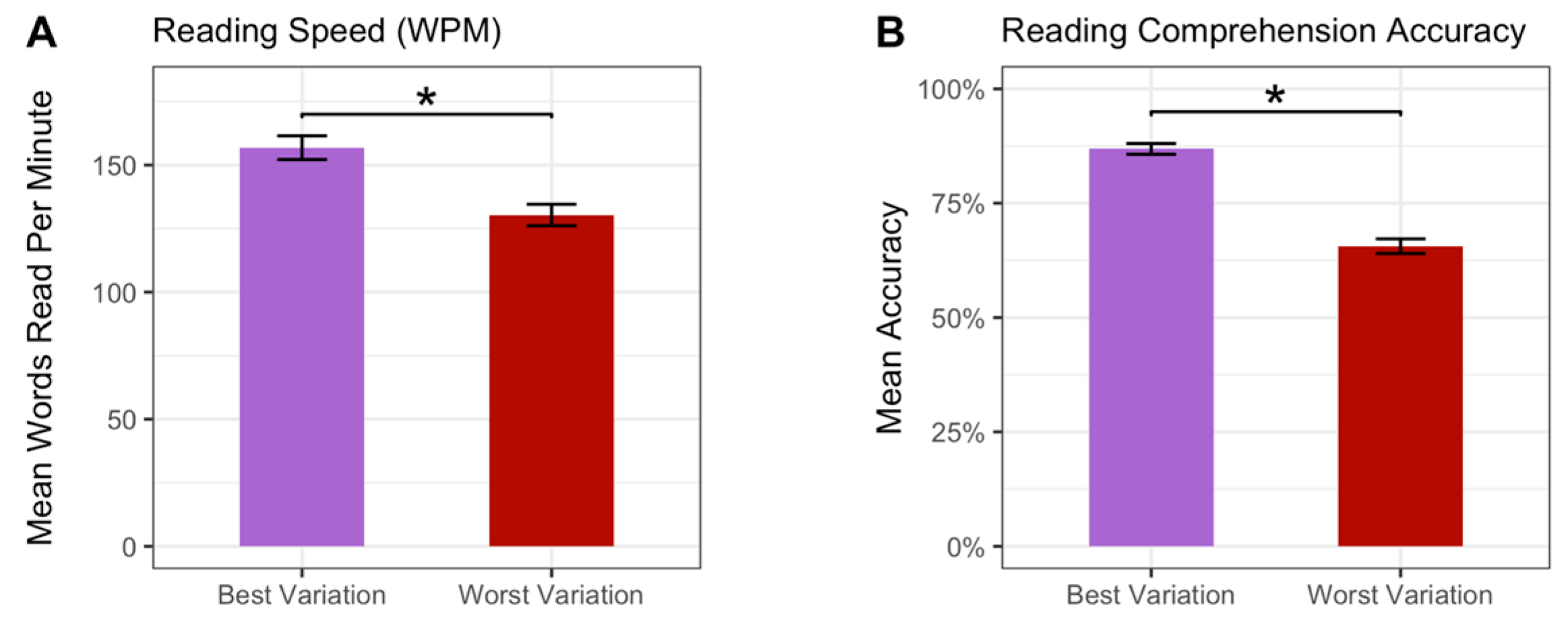
| Grade | ||||||||||
|---|---|---|---|---|---|---|---|---|---|---|
| K | 1st | 2nd | 3rd | 4th | 5th | 6th | 7th | 8th | ||
| Mean Age (Years) | 6.0 | 7.1 | 7.1 | 9.2 | 9.8 | 10.9 | 12.3 | 13.0 | 13.9 | |
| Mean Parent Education (Years) | 16.4 | 15.6 | 16.5 | 16.8 | 15.8 | 14.8 | 16.9 | 17.5 | 16.5 | |
| Sex | ||||||||||
| Female Participants (%) | 50% | 50% | 53% | 54% | 46% | 33% | 57% | 25% | 17% | |
| Male Participants (%) | 50% | 50% | 47% | 46% | 54% | 67% | 43% | 75% | 83% | |
| Race | ||||||||||
| African American/Black (%) | 0% | 19% | 0% | 31% | 23% | 8% | 14% | 25% | 0% | |
| American Indian/Alaskan Native (%) | 0% | 19% | 7% | 8% | 8% | 42% | 0% | 0% | 0% | |
| Asian (%) | 0% | 0% | 20% | 15% | 0% | 8% | 0% | 0% | 0% | |
| White (%) | 50% | 44% | 73% | 31% | 46% | 25% | 86% | 75% | 83% | |
| Mixed Race (%) | 38% | 6% | 0% | 8% | 0% | 8% | 0% | 0% | 0% | |
| Undisclosed Race (%) | 13% | 13% | 0% | 8% | 23% | 8% | 0% | 0% | 17% | |
| Ethnicity | ||||||||||
| Hispanic (%) | 38% | 31% | 13% | 15% | 15% | 50% | 29% | 0% | 17% | |
| Grade | Mean Accuracy (%) | SD Accuracy (%) | Mean RT (ms) | SD RT (ms) |
|---|---|---|---|---|
| K | 71.2% | 45.3% | 870 | 448 |
| 1st | 63.8% | 48.1% | 704 | 398 |
| 2nd | 74.3% | 43.7% | 815 | 449 |
| 3rd | 73.6% | 44.1% | 739 | 444 |
| 4th | 79.0% | 40.8% | 690 | 365 |
| 5th | 65.9% | 47.4% | 544 | 335 |
| 6th | 80.4% | 39.7% | 718 | 335 |
| 7th | 82.9% | 37.6% | 592 | 282 |
| 8th | 89.1% | 31.2% | 659 | 332 |
| Reaction Time (Reading Speed) Model | Accuracy (Reading Comprehension) Model | ||||||||||
|---|---|---|---|---|---|---|---|---|---|---|---|
| Estimate | Std. Error | df | T | p-Value | Estimate | Std. Error | df | T | p-Value | ||
| (Intercept) | 330.60 | 116.10 | 94.69 | 2.85 | 0.005 * | (Intercept) | 20.74 | 8.07 | 97.38 | 2.57 | 0.012 * |
| Nar_Width | 7.33 | 16.16 | 16,740.00 | 0.45 | 0.650 | Nar_Width | 1.14 | 2.04 | 16,740.00 | 0.56 | 0.575 |
| Wide_Width | 11.79 | 16.04 | 16,730.00 | 0.74 | 0.462 | Wide_Width | −0.23 | 2.03 | 16,740.00 | −0.12 | 0.908 |
| Med_Space | 13.92 | 16.15 | 16,730.00 | 0.86 | 0.389 | Med_Space | −0.85 | 2.04 | 16,740.00 | −0.42 | 0.675 |
| Wide_Space | 9.64 | 15.99 | 16,740.00 | 0.60 | 0.546 | Wide_Space | 3.05 | 2.02 | 16,740.00 | 1.51 | 0.131 |
| Extreme | −18.42 | 16.05 | 16,740.00 | −1.15 | 0.251 | Extreme | −1.09 | 2.03 | 16,740.00 | −0.54 | 0.590 |
| Grade | −36.55 | 11.64 | 102.30 | −3.14 | 0.002 * | Grade | 1.34 | 0.84 | 124.60 | 1.58 | 0.116 |
| Parent Education | 109.70 | 26.14 | 93.25 | 4.20 | <0.001 * | Parent Education | 10.80 | 1.80 | 92.55 | 6.00 | <0.001 * |
| Accuracy | 0.08 | 0.06 | 16,780.00 | 1.26 | 0.209 | Reaction Time | 0.00 | 0.00 | 16,330.00 | 1.86 | 0.063 |
| Dyslexia | 16.92 | 120.10 | 101.30 | 0.14 | 0.888 | Dyslexia | −5.69 | 8.65 | 120.40 | −0.66 | 0.512 |
| Other Disability/Disorder | 248.70 | 92.28 | 93.17 | 2.70 | 0.008 * | Other Disability/Disorder | 17.54 | 6.35 | 92.22 | 2.76 | 0.007 * |
| Nar_Width*Grade | −1.46 | 3.76 | 16,740.00 | −0.39 | 0.697 | Nar_Width*Grade | −0.36 | 0.47 | 16,740.00 | −0.77 | 0.443 |
| Wide_Width*Grade | 1.03 | 3.74 | 16,730.00 | 0.28 | 0.782 | Wide_Width*Grade | −0.29 | 0.47 | 16,740.00 | −0.62 | 0.535 |
| Med_Space*Grade | 0.17 | 3.76 | 16,730.00 | 0.05 | 0.965 | Med_Space*Grade | 0.24 | 0.47 | 16,740.00 | 0.51 | 0.607 |
| Wide_Space*Grade | 0.48 | 3.74 | 16,740.00 | 0.13 | 0.897 | Wide_Space*Grade | −0.99 | 0.47 | 16,740.00 | −2.10 | 0.036 * |
| Extreme*Grade | 5.11 | 3.73 | 16,740.00 | 1.37 | 0.171 | Extreme*Grade | −0.31 | 0.47 | 16,740.00 | −0.65 | 0.514 |
| Nar_Width*Dyslexia | −17.44 | 37.22 | 16,730.00 | −0.47 | 0.639 | Nar_Width*Dyslexia | 3.38 | 4.70 | 16,740.00 | 0.72 | 0.473 |
| Wide_Width*Dyslexia | −58.81 | 37.08 | 16,730.00 | −1.59 | 0.113 | Wide_Width*Dyslexia | 5.03 | 4.69 | 16,740.00 | 1.07 | 0.283 |
| Med_Space*Dyslexia | −0.34 | 37.34 | 16,730.00 | −0.01 | 0.993 | Med_Space*Dyslexia | 5.68 | 4.72 | 16,730.00 | 1.21 | 0.228 |
| Wide_Space*Dyslexia | −74.31 | 37.55 | 16,730.00 | −1.98 | 0.048 * | Wide_Space*Dyslexia | 6.02 | 4.74 | 16,740.00 | 1.27 | 0.205 |
| Extreme*Dyslexia | −33.93 | 37.10 | 16,740.00 | −0.92 | 0.360 | Extreme*Dyslexia | −3.53 | 4.69 | 16,740.00 | −0.75 | 0.451 |
| Estimate | Std. Error | t | p-Value | |
|---|---|---|---|---|
| (Intercept) | 51.14 | 5.92 | 8.63 | <0.001 * |
| Grade | −1.12 | 0.51 | −2.20 | 0.030 * |
| Parent Education | 1.40 | 1.18 | 1.18 | 0.240 |
| Reading Enjoyment | −1.54 | 1.11 | −1.39 | 0.169 |
| Dyslexia | 2.57 | 4.52 | 0.57 | 0.570 |
| Other Disability/Disorder | 0.84 | 3.74 | 0.23 | 0.823 |
| Mean Overall Accuracy | −0.32 | 0.08 | −4.18 | <0.001 * |
| Mean Overall RT | −0.01 | 0.01 | −1.70 | 0.094 |
| Grade | Mean Number of Words | Mean Lexile |
|---|---|---|
| Kindergarten | 240 | 87 |
| 1st | 350 | 114 |
| 2nd | 430 | 138 |
| 3rd | 520 | 128 |
| 4th | 695 | 234 |
| 5th | 795 | 266 |
| 6th | 905 | 386 |
| 7th | 1000 | 392 |
| 8th | 1085 | 498 |
| Grade | Mean Accuracy (%) | SD Accuracy (%) | Mean WPM | WPM SD |
|---|---|---|---|---|
| K | 93.8% | 17.7% | 95 | 58 |
| 1st | 86.5% | 18.5% | 146 | 62 |
| 2nd | 66.7% | 26.0% | 133 | 70 |
| 3rd | 71.8% | 31.8% | 154 | 71 |
| 4th | 76.9% | 18.1% | 141 | 70 |
| 5th | 65.3% | 29.8% | 142 | 81 |
| 6th | 76.2% | 19.9% | 106 | 65 |
| 7th | 70.8% | 31.6% | 187 | 81 |
| 8th | 83.3% | 21.8% | 228 | 84 |
| Words Per Minute (Reading Speed) Model | Accuracy (Reading Comprehension) Model | ||||||||||
|---|---|---|---|---|---|---|---|---|---|---|---|
| Estimate | Std. Error | df | t | p-Value | Estimate | Std. Error | df | t | p-Value | ||
| (Intercept) | 193.24 | 31.99 | 122.15 | 6.04 | <0.001 * | (Intercept) | 63.64 | 16.73 | 310.67 | 3.80 | <0.001 * |
| Nar_Width | 0.51 | 11.73 | 499.49 | 0.04 | 0.965 | Nar_Width | −5.78 | 12.70 | 471.41 | −0.46 | 0.649 |
| Wide_Width | −5.34 | 9.65 | 498.56 | −0.55 | 0.580 | Wide_Width | −3.01 | 10.64 | 508.16 | −0.28 | 0.778 |
| Med_Space | −17.64 | 10.97 | 506.05 | −1.61 | 0.108 | Med_Space | −16.58 | 11.10 | 356.18 | −1.49 | 0.136 |
| Wide_Space | −41.63 | 11.87 | 504.33 | −3.51 | <0.001 * | Wide_Space | −15.14 | 12.06 | 353.85 | −1.26 | 0.210 |
| Extreme | −71.92 | 10.53 | 501.52 | −6.83 | <0.001 * | Extreme | −14.09 | 11.30 | 467.90 | −1.25 | 0.213 |
| Grade | −2.01 | 5.43 | 489.93 | −0.37 | 0.712 | Grade | −7.03 | 5.30 | 526.66 | −1.33 | 0.185 |
| Parent Education | −17.17 | 6.76 | 94.06 | −2.54 | 0.013 * | Parent Education | 5.32 | 2.07 | 97.56 | 2.57 | 0.012 * |
| Lexile | 0.05 | 0.04 | 490.38 | 1.36 | 0.174 | Lexile | 0.02 | 0.04 | 550.08 | 0.47 | 0.635 |
| Accuracy | 0.05 | 0.03 | 478.44 | 1.36 | 0.175 | Words Read Per Minute | 0.01 | 0.03 | 145.85 | 0.23 | 0.820 |
| Dyslexia | 60.02 | 34.72 | 151.83 | 1.73 | 0.086 | Dyslexia | 30.59 | 19.04 | 308.57 | 1.61 | 0.109 |
| Other Disability/Disorder | −24.69 | 23.88 | 94.33 | −1.03 | 0.304 | Other Disability/Disorder | 0.43 | 7.18 | 95.17 | 0.06 | 0.953 |
| Nar_Width:Grade | −1.08 | 2.93 | 497.84 | −0.37 | 0.712 | Nar_Width:Grade | 3.18 | 3.21 | 486.16 | 0.99 | 0.322 |
| Wide_Width:Grade | −0.28 | 2.61 | 503.74 | −0.11 | 0.914 | Wide_Width:Grade | 2.22 | 2.80 | 483.00 | 0.79 | 0.429 |
| Med_Space:Grade | 11.60 | 2.80 | 511.99 | 4.14 | <0.001 * | Med_Space:Grade | 3.26 | 2.77 | 347.25 | 1.18 | 0.240 |
| Wide_Space:Grade | 3.03 | 2.94 | 505.09 | 1.03 | 0.304 | Wide_Space:Grade | 5.14 | 2.99 | 361.16 | 1.72 | 0.087 |
| Extreme:Grade | 16.53 | 2.60 | 505.40 | 6.37 | <0.001 * | Extreme:Grade | 4.53 | 2.75 | 470.44 | 1.65 | 0.101 |
| Nar_Width:Dyslexia | −1.95 | 22.49 | 490.28 | −0.09 | 0.931 | Nar_Width:Dyslexia | −58.76 | 26.06 | 552.16 | −2.25 | 0.025 * |
| Wide_Width:Dyslexia | −4.19 | 22.42 | 499.00 | −0.19 | 0.852 | Wide_Width:Dyslexia | −38.51 | 25.19 | 546.06 | −1.53 | 0.127 |
| Med_Space:Dyslexia | −81.09 | 25.85 | 527.16 | −3.14 | 0.002 * | Med_Space:Dyslexia | −31.54 | 24.17 | 338.48 | −1.31 | 0.193 |
| Extreme:Dyslexia | −111.58 | 34.81 | 531.21 | −3.21 | 0.001 * | Extreme:Dyslexia | −36.35 | 31.68 | 326.58 | −1.15 | 0.252 |
| Estimate | Std. Error | t | p-Value | |
|---|---|---|---|---|
| (Intercept) | 47.35 | 18.21 | 2.60 | 0.011 * |
| Grade | 0.23 | 1.16 | 0.20 | 0.843 |
| Parent Education | 0.80 | 2.72 | 0.29 | 0.769 |
| Reading Enjoyment | −2.25 | 2.70 | −0.83 | 0.407 |
| Dyslexia | 23.03 | 11.40 | 2.02 | 0.046 * |
| Other Disability/Disorder | −5.55 | 8.99 | −0.62 | 0.539 |
| Mean Overall Accuracy | −0.37 | 0.13 | −2.82 | 0.006 * |
| Mean Overall WPM | 0.04 | 0.04 | 1.09 | 0.277 |
Disclaimer/Publisher’s Note: The statements, opinions and data contained in all publications are solely those of the individual author(s) and contributor(s) and not of MDPI and/or the editor(s). MDPI and/or the editor(s) disclaim responsibility for any injury to people or property resulting from any ideas, methods, instructions or products referred to in the content. |
© 2023 by the authors. Licensee MDPI, Basel, Switzerland. This article is an open access article distributed under the terms and conditions of the Creative Commons Attribution (CC BY) license (https://creativecommons.org/licenses/by/4.0/).
Share and Cite
Sheppard, S.M.; Nobles, S.L.; Palma, A.; Kajfez, S.; Jordan, M.; Crowley, K.; Beier, S. One Font Doesn’t Fit All: The Influence of Digital Text Personalization on Comprehension in Child and Adolescent Readers. Educ. Sci. 2023, 13, 864. https://doi.org/10.3390/educsci13090864
Sheppard SM, Nobles SL, Palma A, Kajfez S, Jordan M, Crowley K, Beier S. One Font Doesn’t Fit All: The Influence of Digital Text Personalization on Comprehension in Child and Adolescent Readers. Education Sciences. 2023; 13(9):864. https://doi.org/10.3390/educsci13090864
Chicago/Turabian StyleSheppard, Shannon M., Susanne L. Nobles, Anton Palma, Sophie Kajfez, Marjorie Jordan, Kathy Crowley, and Sofie Beier. 2023. "One Font Doesn’t Fit All: The Influence of Digital Text Personalization on Comprehension in Child and Adolescent Readers" Education Sciences 13, no. 9: 864. https://doi.org/10.3390/educsci13090864
APA StyleSheppard, S. M., Nobles, S. L., Palma, A., Kajfez, S., Jordan, M., Crowley, K., & Beier, S. (2023). One Font Doesn’t Fit All: The Influence of Digital Text Personalization on Comprehension in Child and Adolescent Readers. Education Sciences, 13(9), 864. https://doi.org/10.3390/educsci13090864






